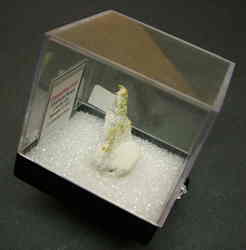 Specimen gold is generally found and retrieved from lode gold deposits. These are usually high-grade occurences found in quartz veins, or less commonly calcite. Gold may also be found as specimens in, or with iron oxides, adularia (a low-temperature feldspar), sulfides, and with other silica-rich minerals such as tourmaline, amythest, or clay minerals.
Specimen gold is generally found and retrieved from lode gold deposits. These are usually high-grade occurences found in quartz veins, or less commonly calcite. Gold may also be found as specimens in, or with iron oxides, adularia (a low-temperature feldspar), sulfides, and with other silica-rich minerals such as tourmaline, amythest, or clay minerals.
Gold crystallizes in the isometric system. Many of the most common isometric crystal shapes such as cubes, octahedrons (pyramid-like), are very uncommon. Natural gold crystals tend to be distorted, thus it typically forms skeletal crystals, sheets, leafs, wires, and dendritic forms. Very rarely a trigon is found on the surfaces of leaf gold. This triangle appears as though stamped or engraved on the leaf gold surfaces.
The greatest number of gold specimens exhibit a "crystalline" form. This irregular gold specimen display is the result of using Hydrofluoric Acid to dissolve away the quartz matrix from the gold. This will leave a delicate gold specimen that illustrates the complex crystallization forms that the gold assumed as it formed.
All of the gold forms discussed above are available from NorthernNevadaGold.com, either in current or future offerings.
All gold specimens shown are mounted in either a 1" x 1" Thumbnail "Perky-Box" or a 2" x 2" Miniature "Perky-Box". All have labels on the bottom of box, and inside box, giving Name, Location, and weights.
Click here to see Gold Specimens for Sale